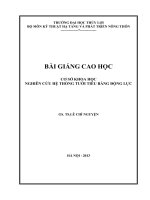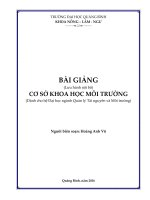Bài giảng Cơ sở khoa học của biến đổi khí hậu (Đại cương về BĐKH) – Phần I: Bài 8 – ĐH KHTN Hà Nội
Bạn đang xem bản rút gọn của tài liệu. Xem và tải ngay bản đầy đủ của tài liệu tại đây (29.09 MB, 47 trang )
VNU HANOI UNIVERSITY OF SCIENCE
REGIONAL CLIMATE MODELING AND CLIMATE CHANGE
CƠ SỞ KHOA HỌC
CỦA BIẾN ĐỔI KHÍ HẬU
(Đại cương về BĐKH)
Phần I
----------------------------------------------------------Phan Van Tan
B8: Hồn lưu khí quyển và phân bố khí áp
Hồn lưu khí quyển: Mơ hình vịng đơn
| George Hadley đã tiến hành nghiên cứu hoàn lưu chung
từ 1735
| Hadley đã cố gắng hình thành một mơ hình hồn lưu
chung trong đó kết hợp các quan trắc của các thuỷ thủ là
gió ở gần xích đạo thổi từ đơng sang tây
| Hadley đã đưa ra một mơ hình vịng đơn (một vịng):
{ Độ dày lớp khí quyển thay đổi theo nhiệt độ từ cực đến xích
đạo
{ Lực gradient khí áp được thiết lập
{ Gió bắt đầu thổi
{ Lực Coriolis ảnh hưởng đến gió
Hồn lưu khí quyển: Mơ hình vịng đơn
Hồn lưu khí quyển: Mơ hình vịng đơn
WIND
North Pole
Equator
Hồn lưu khí quyển: Mơ hình vịng đơn
Hồn lưu khí quyển: Mơ hình vịng đơn
| Mơ hình vịng đơn có cả các thành phần gió N-S và E-W
{ Thành phần E-W: Gió vĩ hướng
{ Thành phần N-S: Gió kinh hướng
| Đóng góp chính của Hadley:
{ Giải thích hoàn lưu trực tiếp do nhiệt gây nên bởi sự
đốt nóng khác nhau
{ Gió vĩ hướng sinh ra từ sự lệch hướng của gió kinh
hướng do ảnh hưởng của lực Coriolis
| Mơ hình vịng đơn của Hadley q đơn giản
{ Lý thuyết không phù hợp với kết quả quan trắc
| Hơn 100 năm sau đó, vào năm 1865, William Ferrel đề
xuất mơ hình ba vịng
Hồn lưu khí quyển: Mơ hình ba vịng
| Ở mỗi bán cầu có 3 vịng hồn lưu chung:
{ Vịng Hadley: Hoàn lưu trực tiếp do nhiệt ở các vùng nhiệt
đới/cận nhiệt đới
{ Vịng Ferrel: Ở các vĩ độ trung bình
{ Vòng cực: Ở các vĩ độ cao
Mơ hình ba vịng: Vịng Hadley
| Vịng Hadley về cơ bản là mơ hình một vịng được giới
hạn ở các vùng nhiệt đới/cận nhiệt đới
{ Gây nên bởi sự đốt nóng mạnh ở gần xích đạo
{ ITCZ tạo ra một dải ổn định của mây, mưa rào, dông
UP
300 mb
300 mb
COOLER
H
20oN
HOT
L
Equator
Intertropical Convergence Zone (ITCZ)
COOLER
H
20oS
Mơ hình ba vịng: Vịng Hadley
| Vịng Hadley tạo ra sự đa dạng các hiện tượng thời tiết
{ ITCZ (nhánh đi lên)
{ Đới lặng gió: (vùng xích đạo êm ả) là vùng lặng gió trong ITCZ
{ Áp cao cận nhiệt đới: Khu vực khí áp bề mặt cao, ổn định, trời
quang, lặng gió (nhánh đi lên)
{ Tín phong: Gió ổn định hướng đơng bắc (NH) và đơng nam (SH)
trong dịng bề mặt
Mơ hình ba vịng: Vịng cực
| Vịng cực, như vịng Hadley, phát sinh do hoàn lưu nhiệt
trực tiếp
UP
300 mb
LESS COLD
70oN
North Pole
Mơ hình ba vịng: Vịng Ferrel
| Vịng Ferrel phát sinh do ảnh hưởng ma sát của vòng
Hadley và vòng cực
Mơ hình 3 vịng có hiện thực?
| Vịng Hadley mơ tả tốt hồn lưu nhiệt đới và cận nhiệt
đới
| Vịng Ferrel và vịng cực chỉ phản ánh điều kiện trung
bình nhiều năm, khơng mơ tả được hình thế tức thời
è Vịng Ferrel cho thấy dịng gió đơng ở cả hai bán cầu
trong khí quyển trên cao
è Dịng xiết là gió tây (cả NH và SH)
| Thực tế: Các trung tâm khí áp bán vĩnh cửu
{ Các trung tâm khí áp bề mặt bán vĩnh cửu khác nhau tồn tại
xung quanh Trái đất là do:
| Sự tương phản nhiệt độ
| Các q trình động lực (tức là các xốy di chuyển lặp đi
lặp lại qua cùng một vùng nào đó)
Các trung tâm khí áp bán vĩnh cửu
| Mạnh nhất về mùa đông:
{ Áp thấp Aleut/Iceland: Gây nên bởi các xốy có đường đi ổn
định qua các đại dương bắc Đại tây dương/Thái bình dương
{ Áp cao Siberi: Gây nên bởi vùng khí áp cao liên quan với
khơng khí lục địa rất lạnh
| Mạnh nhất về mùa hè:
{ Áp cao Hawaii: Gây nên bởi sự tương phản giữa khơng khí
biển tương đối lạnh và khơng khí lục địa ấm hơn
{ Áp thấp Tibet/Tây Nam U.S.: Gây nên bởi sự tương phản
giữa khơng khí sa mạc nóng và khơng khí mát hơn ở xung
quanh
Dịch chuyển mùa của các trung tâm khí áp bán
vĩnh cửu và ITCZ
| Các trung tâm khí áp bán vĩnh cửu và ITCZ chịu sự dịch
chuyển mùa cả về cường độ và vị trí
| Những biến đổi này dẫn đến:
{ Mùa mưa/mùa khơ gần xích đạo (liên quan với vị trí của ITCZ)
{ Gió mùa – làm gia tăng giáng thuỷ đáng kể vào mùa mưa (liên quan
với sự mạnh lên của các trung tâm áp thấp/áp cao về mùa hè)
January
July
Gió mùa
Gió mùa châu Á
| Gió mùa ảnh hưởng chính đến giáng
thuỷ địa phương
Gió mùa
châu Á
Gió mùa Tây Nam U.S.
| Sa mạc Tây Nam U.S. cũng chịu ảnh hưởng của mưa
theo mùa do các trung tâm khí áp bán vĩnh cửu về mùa
hè
Những đặc điểm trong tầng đối lưu trên
| Trở lại với gió và gradient khí áp:
1) Khơng khí ấm hơn thì dày hơn khơng khí lạnh
2) Khơng khí ở xích đạo ấm hơn ở các cực
3) Độ cao mực 500-mb giảm từ xích đạo về hai cực
| Độ cao mực 500-mb biến đổi từ xích đạo về các cực như
thế nào? Biến đổi mùa như thế nào?
Biến đổi mùa của độ cao mực 500-mb
| Có 4 đặc trưng quan trọng liên quan với sự biến đổi mùa
của độ cao mực 500-mb:
1) Độ cao giảm về hai đầu cực
2) Gradient độ cao lớn nhất về mùa đông
3) Về mùa hè độ cao cao hơn về mùa đông ở mọi nơi
4) Về mùa đông gradient độ cao lớn nhất ở phía nam
| Gió phản ứng lại với trường độ cao (khí áp) theo mùa
như thế nào?
{ Độ cao giảm về hai cực
| Kết quả: Gió tây ở tầng đối lưu trên
{ Gradient lớn nhất về mùa đông
| Kết quả: Gió tây mạnh nhất về mùa đơng
Biến đổi mùa của độ cao mực 500-mb
| Gió phản ứng lại với trường độ cao (khí áp) theo mùa
như thế nào?
{ Độ cao về mùa hè cao hơn về mùa đông ở mọi nơi
| Kết quả: Không thực sự quan trọng, quan trọng hơn là
gradient độ cao
{ Về mùa đơng gradient độ cao lớn nhất ở phía nam
| Kết quả: Gió tây về mùa đơng mạnh nhất ở phía nam
| Tóm lại, về mùa đơng gió tây ở tầng đối lưu trên là
mạnh nhất ở phía nam
| Cái gọi là “gió tây mạnh nhất” ở tầng đối lưu trên được
biết đến là DÒNG XIẾT
Dòng xiết
| Dòng xiết là một dải ở tầng đối lưu trên (rộng hàng trăm
km) ở đó gió có tốc độ rất lớn, có thể tới 45-90m/s
(100-200mph)
1) Theo phương ngang, dịng xiết nằm ở nơi có gradient độ cao
(khí áp) lớn nhất
2) Theo phương thẳng đứng, dòng xiết nằm ở đỉnh tầng đối lưu
s clouds had revealed
oving rapidly indeed.
erage position of the
of air for the Norththis diagram, we can
e
t
forms on the poleward (north) side of the Hadley cell, at
a higher altitude than the polar jet stream. Here, warm
Dòng xiết
*The subtropical jet stream is normally found between 20° and 30° latitude.
Global Winds
201
DID YOU KNOW?
Strong upper-level winds during April, 2010, blew tons of
dust and ash from an Icelandic volcano over much of western
Europe. The ash cloud closed most of the continent’s airports
for a week, which in turn affected more than a million passengers a day, and cost the airline industry more than $1.7 billion
in lost revenues.
air aloft carried poleward by the Hadley cell produces
sharp temperature differences, strong pressure gradients, and high winds. ◗ Figure 7.32 illustrates how the
polar jet stream and the subtropical jet stream might appear as they sweep around the earth in winter.
We can better see the looping pattern of the jet by
studying ◗ Fig. 7.33a, which shows the position of the
polar jet stream and the subtropical jet stream at the
300-mb level (near 9 km or 30,000 ft) on March 9, 2005.
The fastest flowing air, or jet core, is represented by
Active ◗FIGURE 7.32 Jet streams are swiftly flowing curthe heavy dark arrows. The map shows a strong polar
rents of air that move in a wavy west-to-east direction. The
figure shows the position of the polar jet stream and subtropjet stream sweeping south over the Great Plains with
pied, scanned, or duplicated, in whole or in part. Due to electronic an
rights,
some third
party content
may be suppressed
from
the Gulf
eBook and/or
ical jet stream in winter. Although jet streams are shown as
equally
strong
subtropical
jet over
the
states.eChapter(s).
rially affect the overall learning experience. Cengage Learning reserves the right to remove additional content at any time if subsequent rights restrictions
it.
one require
continuous
river of air, in reality they are discontinuous,
Notice that the polar jet has a number of loops, with
with their position varying from one day to the next.
one off the west coast of North America and another
over eastern Canada. Observe in the satellite image
15/11/10 11:30 AM
rects cold air equatorward; where the air flows north(Fig. 7.33b) that the polar jet stream (blue arrow) is diward, warm air is carried toward the poles. Jet streams,
recting cold, polar air into the Plains States, while the
therefore, play a major role in the global transfer of heat.
subtropical jet stream (orange arrow) is sweeping subMoreover, since jet streams tend to meander around the
tropical moisture, in the form of a dense cloud cover,
world, we can easily understand how pollutants or volover the southeastern states.
canic ash injected into the atmosphere in one part of the
The looping pattern of the polar jet stream has an
globe could eventually settle to the ground many thouimportant function. In the Northern Hemisphere,
| Jet streams occur near the tropopause
| Subtropical jet defines the limit of the Hadley Cell
| Polar jet is equatorward of the polar front
stream or, simply, the polar jet stream.
In Fig. 7.31, the wind in the center of the jet stream
would be flowing as a westerly wind away from the
viewer. This direction, of course, is only an average, as
jet streams often flow in a wavy west-to-east pattern.
When the polar jet stream flows in broad loops that
sweep north and south, it may even merge with the subtropical jet. Occasionally, the polar jet splits into two jet
streams. The jet stream to the north is often called the
northern branch of the polar jet, whereas the one to the
south is called the southern branch.
Since jet streams are bands of strong winds, they
form in the same manner as all winds do—from horizontal differences in air pressure. In Fig. 7.31, notice
that the polar jet stream forms along the polar front
where sharp contrasts in temperature produce rapid
horizontal pressure changes and strong winds. Due to
the fact that the north-to-south temperature contrasts
along the front are greater in winter than they are in
summer, the polar jet stream shows seasonal variations.
In winter, the polar jet stream winds are stronger and
the jet moves farther south, sometimes as far south as
Florida and Southern California. In summer, the polar
jet stream is weaker and forms over higher latitudes.
Observe in Fig. 7.31 that the subtropical jet stream
forms on the poleward (north) side of the Hadley cell, at
a higher altitude than the polar jet stream. Here, warm
Dịng xiết
| Có hai dạng dòng xiết:
{ Dòng xiết cực
find rivers of fast-flowing air—what
| Nằm ở các vĩ độ trung
.
et streams are swiftly flowing airbình
curmiles long, normally less than several
e, and typically less than
thick. phối hầu hết điều
| a mile Chi
e central core of a jet stream often exkiện thời tiết vĩ độ trung
d occasionally 200 knots. Jet streams
at the tropopause at elevations
bebình
km (33,000 and 46,000 ft) although
both higher and
altitudes. xiết cận nhiệt đới
{ lowerDòng
ere first encountered by high-flying
uring World War II, but their exis| Nằm ở các vĩ độ cận
ed before that time. Ground-based
st-moving cirrus clouds had revealed
nhiệt đới
s aloft must be moving rapidly indeed.
lustrates the average position
the nhánh hướng cực của
| ofDo
neral circulation of air for the Northvòng
Hadley
n winter. From this diagram, we
can
age annual precipitation for Los Angeles,
ta, Georgia.
age position of the
the subtropical jet
to a model of the
n winter. Both jet
from west to east.
*The subtropical jet stream is normally found between 20° and 30° latitude.
DID YOU KNOW?
Strong upper-level winds during April, 2010, blew tons of
dust and ash from an Icelandic volcano over much of western
Europe. The ash cloud closed most of the continent’s airports
for a week, which in turn affected more than a million passengers a day, and cost the airline industry more than $1.7 billion
in lost revenues.
air aloft carried poleward by the Hadley cell produces
sharp temperature differences, strong pressure gradients, and high winds. ◗ Figure 7.32 illustrates how the
polar jet stream and the subtropical jet stream might appear as they sweep around the earth in winter.
We can better see the looping pattern of the jet by
studying ◗ Fig. 7.33a, which shows the position of the
polar jet stream and the subtropical jet stream at the
300-mb level (near 9 km or 30,000 ft) on March 9, 2005.
Global Winds
201









